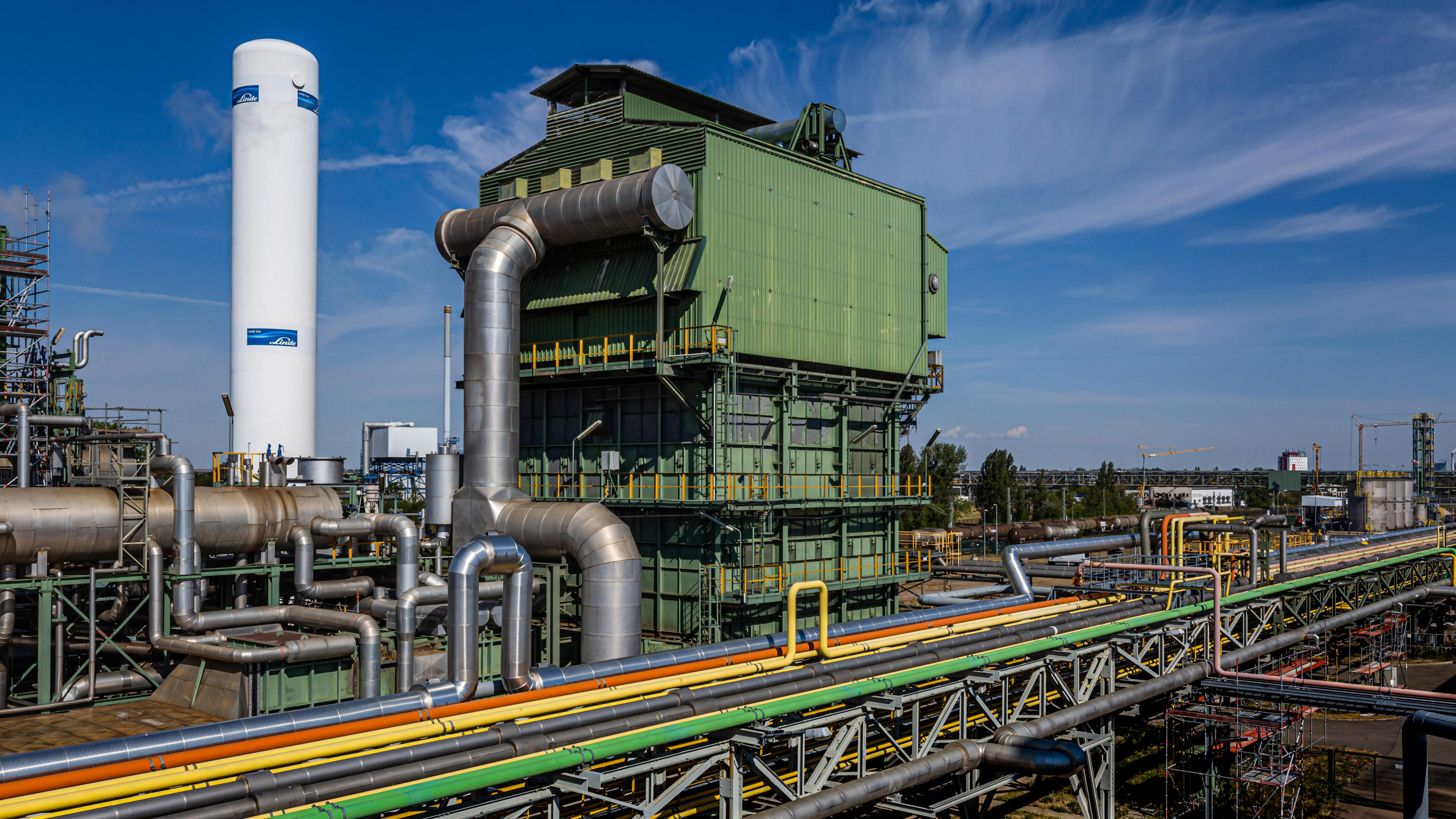When hydrogen will help climate change—and when it won’t.
Hydrogen could be key to addressing climate change, but where it comes from will matter.

This article is from The Spark, MIT Technology Review's weekly climate newsletter. To receive it in your inbox every Wednesday, sign up here.
Have you ever heard of the hydrogen rainbow?
While hydrogen gas is colorless, the industry sometimes uses colors as shorthand to describe which of the many possible processes was used to make a particular batch. There’s gray, green, and blue hydrogen, along with more vibrant tones like pink—a whole rainbow (kind of).
Hydrogen is often heralded as a climate hero because when it’s used as a fuel in things like buses or steel production, there are no direct carbon emissions (or related warming) to worry about. As the world tries to cut down on our use of fossil fuels, there could be plenty of new demand for this carbon-free energy source.
But how hydrogen is made could determine just how helpful it is for the climate. That’s where the rainbow comes in. (I’ve added an at-a-glance table below so you can untangle all these colors.)
Last week, the European Commission released rules that define what “renewable” hydrogen is: in other words, what it means for hydrogen to be green. There was also a fascinating story in Science last week about naturally occurring, or gold, hydrogen.
So let’s dive into the hydrogen rainbow and explore where this fuel of the future might come from.
What do we need hydrogen for?
We already use a lot of hydrogen today: global demand was 94 million metric tons (Mt) in 2021. Most of that was used for oil refining, as well as production of ammonia (for fertilizer) and methanol (for chemical manufacturing).
That is likely to change in the future, because it’s also a good replacement for fossil fuels in transportation, heavy industry, and other sectors. If countries keep their climate pledges, hydrogen demand could reach 130 Mt by 2030, and about a quarter of that would be for new uses.
The problem is, making hydrogen today overwhelmingly requires fossil fuels, usually natural gas. In so-called “gray” hydrogen production, natural gas reacts with water, generating hydrogen gas and giving off carbon emissions.
It doesn’t have to be that way, though. For one thing, we could try to capture the carbon emissions from fossil-powered hydrogen production (this method yields so-called blue hydrogen). This is a pretty controversial approach, because carbon capture is expensive and doesn’t always work efficiently.
Alternatively, we could rethink the process altogether and start using electricity to make hydrogen instead. This process uses an electrolyzer: water and electricity go in; hydrogen and oxygen come out. If the electricity powering that reaction comes from renewable sources, hydrogen officially earns the distinction of being “green.”
What does it mean to be green?
That’s the question the European Commission is trying to answer with its new rules released last week. The goal is to lay out which hydrogen projects will count for climate goals and be eligible for special funding. (That funding is important because green hydrogen is significantly more expensive than fossil-derived gray hydrogen today.)
There are two big pieces to these new rules. First, green hydrogen will need to be produced using renewable electricity. Producers will have to either hook up directly to solar and wind farms or get electricity from the grid and sign contracts with renewable electricity generators.
There’s a lot of renewable electricity in play here. As part of its plan to cut emissions and dependence on Russian fossil fuels, the EU is trying to reach 10 million metric tons of domestic hydrogen production annually by 2030, along with 10 million more in imports.
Reaching that domestic production goal will require 500 TWh of renewable electricity. That’s nearly 15% of total EU electricity consumption.
Because there’s so much electricity needed to meet hydrogen demand, regulators are trying to avoid a scenario where hydrogen production just sucks up all the existing renewable capacity.
To combat this, the commission will require hydrogen producers to adhere to a principle called additionality. Basically, hydrogen producers should be adding new renewables to the grid, not hogging old ones. So new requirements say that hydrogen producers must use renewable energy projects built recently (within the last three years).
The rules still need to be approved, which could take a few months. In the US, similar rules regarding tax credits for hydrogen in the Inflation Reduction Act are currently being developed by the Biden administration, so we should know more soon about what green means for that market.
What if hydrogen grew on trees?
Okay, not trees exactly, but what about underground? This story, published last week in Science, digs into the possibility of naturally occurring hydrogen.
Hydrogen isn’t something that’s considered to be widespread in nature (look at all those intense ways we’ve come up with to make it!). But some researchers are starting to change their minds about just how plentiful it might be.
A few exploratory wells have turned up pretty clear streams of hydrogen, and now people are starting to search for reserves across Australia, Africa, and Europe. As for why we hadn’t found it before, hydrogen wouldn’t occur in the same places as oil and gas, and not many people would have gone looking for it in the past. (Natural hydrogen is sometimes given the color “gold,” by the way.)
The wild thing is, this hydrogen might actually be a renewable resource. That’s because reactions that make it may occur naturally underground when water reacts with rocks. It could be pretty inexpensive to extract, too. There are a lot of questions left before we give up our electrolyzers, but it’s really interesting to see the hydrogen rainbow add yet another color.
If you’ve had trouble keeping all these colors straight, you’re not alone. At the end of the day, the most important thing to know isn’t what nickname is assigned to a particular hydrogen source, but what the resulting emissions are. But if you want a rainbow reference, here’s a chart!
Note that this isn’t a complete list, and there may be alternative definitions for some colors.
Green hydrogen was one of our 10 Breakthrough Technologies in 2021—check out this feature for more on what’s at stake and what it will take to make it a reality.

Another thing
New batteries are coming to the US. Ford announced last week that it plans to build a factory in Michigan that will produce a type of lithium-ion battery made mostly in China today. These batteries could unlock cheaper, longer-lasting electric vehicles in North America. Read my story for more on the technology and what’s next for this factory.
There have been a lot of shifting dynamics around this facility, though, and some remaining uncertainty, because Ford plans to license technology from Chinese battery giant CATL to build the batteries. In his newsletter this week, my colleague Zeyi Yang dove into why batteries have gotten so politicized recently.
Zeyi also published a story this week about how China set up its EV industry for success, which I highly recommend.
Keeping up with climate
The war in Ukraine began one year ago this week. Since then, it has transformed Europe’s energy landscape, speeding progress in renewables as countries have worked to cut their dependence on Russian fossil fuels. (Bloomberg)
Just how good is that electric truck for the planet? Depends on what you’re comparing it to. I liked the visualizations in this piece showing the spread of emissions from different vehicle models. (New York Times)
→ Read last week’s newsletter for more on massive EVs. (MIT Technology Review)
The “15-minute city” is an urban planning idea centered around dense communities, which can help cut emissions and make life a little bit more enjoyable (who wouldn’t mind a shorter commute?). But the concept has morphed into a conspiracy theory online. (Wired)
Tesla will open up some of its chargers in the US to all EV drivers. The move comes after a lot of campaigning from the Biden administration. (Washington Post)
→ I talked about this and other science news stories on Science Friday last week! Check out the segment for more. (Science Friday)
Cryptocurrency miners are trying to remake their image to appear more climate-friendly. Environmental groups and researchers are rightly skeptical. (Grist)
United Airlines is pouring money into new fuels, launching a $100 million fund this week to invest in new and existing “sustainable aviation fuel” projects. (Canary Media)
→ This isn’t the airline’s first rodeo in this space: last year I wrote about one of its investments, a company making fuel with microbes. (MIT Technology Review)
Production of nickel, a metal used in EV batteries, doubled between 2020 and 2022 in Indonesia. The city of Labota is paying the price with pollution and dangerous conditions for workers. (Wired)
Deep Dive
Climate change and energy

This rare earth metal shows us the future of our planet’s resources
The story of neodymium reveals many of the challenges we’ll likely face across the supply chain in the coming century and beyond.

Andrew Ng’s new model lets you play around with solar geoengineering to see what would happen
The climate emulator invites you to explore the controversial climate intervention. I gave it a whirl.

Want to understand the future of technology? Take a look at this one obscure metal.
Here’s what neodymium can tell us about the next century of material demand.
Stay connected
Get the latest updates from
MIT Technology Review
Discover special offers, top stories, upcoming events, and more.
